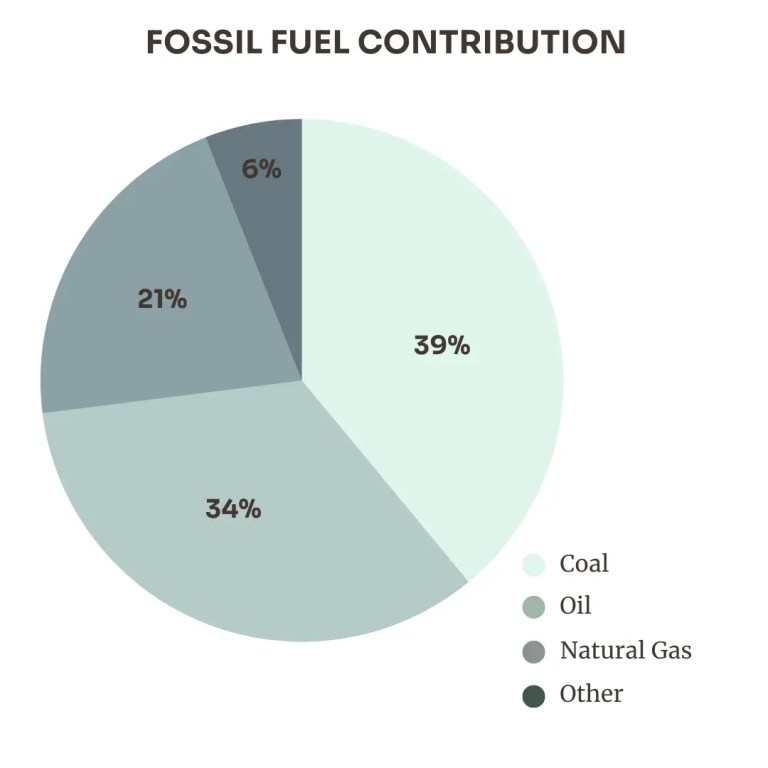Global warming is undeniable, but we all can contribute to saving the Earth. To deal with the damage we have caused, we need to transform our way of life, including our consumption, production, and lifestyles.
What are fossil fuels?
Fossil fuels include coal, oil and natural gas. They were formed from decomposing plants and animals that died millions of years ago, got buried deep underground, and were subject to increasing heat and pressure.
- Coal: Coal is formed from fossilized plants which got buried deep underground and were subjected to intense heat
- Oil: Oil is formed from buried plankton which was exposed to intense heat flow underground
- Natural Gas: Just like oil, natural gas is formed from buried plankton or coal in the late stages of breakdown, but the creation of natural gas requires higher temperatures than oil
Fossil fuels are carbon-rich and are extracted to be burned for energy or utilized in industrial processes. They are a non-renewable energy source, meaning that eventually, the supply will run out and won’t be replenished for millions of years. Fossil fuels currently supply 80% of the world’s energy and are used in many industrial processes and transportation.
How do fossil fuels contribute to the climate crisis?
When fossil fuels are burned, they release carbon dioxide and other greenhouse gases. These gases trap heat in the atmosphere and therefore cause increasing temperature over time, leading to global warming and climate change.
- Coal currently supplies around a third of the energy globally and accounts for 39% of the total carbon dioxide emissions. It is the single biggest source of the global temperature increase, with China, India and the United States being the top coal consumers and producers.
- Oil is extracted from underground through onshore and offshore wells, then the crude oil is refined into a variety of products, including gasoline, diesel, and heating oil. Oil is the second-largest source of climate change accounting for 34% of the total carbon dioxide emissions, with the United States, Saudi Arabia and Russia being the top producers.
- Natural Gas is cleaner in emission than oil and coal, but still accounts for 21% of the total carbon dioxide emissions.

The remaining 6% of carbon dioxide emissions are due to cement, flaring and other industrial processes. Cement is the primary ingredient of concrete, and it is the most widely used construction material in the world. CO2 is emitted due to chemical reactions when making clinker, one of the main ingredients. Flaring is a process used in the global petroleum industry and burns unwanted flammable gases in the open air.
Fossil fuels and the companies and people who produce and use them are actively destroying the planet, and unfortunately, we are all contributing one way or another, mainly through:
- Investments in the most prominent producers (directly financing fossil fuel production)
- Using banks who provide significant financing to these companies (indirectly financing fossil fuel production)
- Buying products that use fossil fuels for production either as ingredients or for industrial processes.
The Paris Agreement
The Paris Agreement signed and ratified by 189 countries is a legally binding international treaty on climate change. It is essentially a commitment to reduce carbon emissions and work together to adapt to the impacts of climate change. The goal is to slow down global warming and to achieve a climate-neutral world by 2050.The Agreement also provides a framework for how countries can support each other through (i) finance: financial assistance to the more vulnerable countries, (ii) technology: the Agreement wants to fully realize technology development and transfer and (iii) capacity-building: support for the developing countries.
Overall, more and more countries and companies recognize the urgency of the climate crisis. However, fossil fuel companies are still actively financed by the largest banks in the world. The Paris Agreement is a significant step forward, being the first binding Agreement bringing all nations into a common cause to combat climate change. Still, we think committing to reduce global warming by 2050 is too late, and we have to act now. As individuals, our options are limited, but there are still steps we can take to make sure our money is not directly or indirectly fueling the crisis.
4 steps to divest from fossil fuels
1. Review your investment portfolio
This is the first and most important step to stay away from financing fossil fuel companies actively. Check your investments and how they are related to the fossil fuel industry and divest if necessary. The Fossil Free Funds website is a handy tool to check your existing investments and find new fossil fuel-free ones. By cleaning your investments, you are joining one of the fastest-growing divestment movements in the world.
Go Fossil Free aims to immediately freeze any new investment in fossil fuel companies and divest from all investments that include fossil fuel. Numerous large organizations have already pledged to go fossil fuel-free, including the Rockefeller Brothers Fund, City of Oslo, and the Leonardo DiCaprio Foundation. Together they already achieved around 14.6 trillion-dollar divestments. If you want to show your commitment, you can join the individual pledge at DivestInvest, a global network of individuals and organizations who want to use their collective influence as investors to divest from fossil fuels. You can invest in climate solutions and overall accelerate the transition to a zero-carbon economy.
Divesting fossil fuels is a great and efficient way to do something against climate change personally. You might feel your investments have no impact on these large corporations, but our impact will be very powerful if we work together.
2. Review your company retirement plan (401k, 403b)
If you have a retirement plan with your company, it is invested in financial assets. Many of us have little or no idea about the exact investments and what impact they generate. There is a good chance that your plan is invested in fossil fuels since the largest fund companies consider them mainstream investments.
If you realize that your retirement plan is invested in fossil fuels companies, you could even raise your concerns within your company and drive the change if needed to exclude them actively. More and more companies and organizations feel responsible, and you could be the person they need to start taking some real actions.
3. Check if your bank is a leading fossil fuel financer - and switch to a better one
Many banks are still financing fossil fuel companies (active across the fossil fuel life cycle) by providing loans or actively investing in their shares. The Fossil Fuel Finance Report 2021 found that the world’s 60 largest banks poured a total of 3.8 trillion US dollar into 2,300 fossil fuel companies between 2016–2020. 8 US banks provided one-third of all the financing. You can read our article Dirty Dozen – Banking on Climate Chaos for the full break-down of the report.
The worst 4 banks are also all American:
- JPMorgan Chase: World’s worst funder of fossil fuels for 5 years in a row.
- Citi: Citi is funding the 100 key companies with the worst fossil fuel expansion plans (like ExxonMobil and Enbridge)
- Wells Fargo: World’s top fracking funder companies like Pioneer Natural Resources and Diamondback Energy (fracking is the process of drilling down into the earth to extract oil and gas)
- Bank of America: Provided highest LNG (liquid natural gas) financing in 2020, continuing its support of fracked gas shippers like Sempra and Cheniere
If you realize your current bank is one of the top fossil fuel financing ones, you can choose another bank. You might think you cannot influence what your bank does, but in reality, they can partially finance all these companies from the money we all keep in our accounts. By placing our savings somewhere else, we essentially reduce the money available for fossil fuel financing.
4. See how you can support NGOs and other initiatives to put pressure on politicians
Another way to fight the climate crisis is to either donate to NGOs or see if you could volunteer and support them in any way. A few organizations have been highlighted by Founders Pledge and Giving Green, two groups that research the most effective charities.
Clean Air Task Force: A non-profit environmental organization. Its members are climate and energy experts who want to achieve impact through technology innovation, policy advocacy and thought leadership. They have a long track record of successfully advocating for national-level policy change. Their achievements include co-founding and leading the national US campaign against dirty coal production. These initiatives helped deliver power plant emissions reductions in pollution-causing smog and soot of more than 70 percent and a significant decrease in other air toxic emissions.
Carbon180: A climate-focused NGO working with scientists, businesses, and policymakers to build a world that removes more carbon than it emits. Their work includes, among others, the ‘Leading with Soil’ initiative, where they work with farmers and ranchers to accelerate the adoption of practices that increase soil carbon. Carbon-rich soils lower reliance on external inputs like fertilizer, increase crop yields, enhance land and water resources, and build greater resilience to climate impacts, all while offsetting greenhouse gas (GHG) emissions.
Sunrise Movement: Sunrise Movement is a youth movement aiming to stop climate change. They want to make climate change an urgent priority in the US, end the corrupting influence of fossil fuel executives on politics, and elect leaders who stand up for the health and well-being of all people. They also offer training for everyone who wants to become an active member of the movement.
Articles in the Save the Earth series:
- Save the Earth I: Introduction to the Climate Crisis
- Save the Earth II: Divest from Fossil Fuels
- Save the Earth III: Switch to Renewable Energy
- Save the Earth IV: Make Your Diet Sustainable



